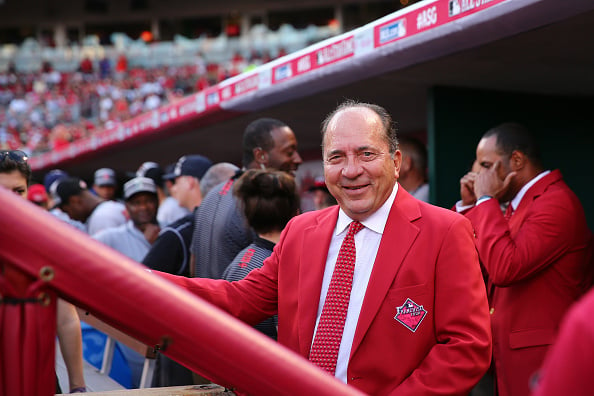What is Johnny Bench's Net Worth?
Johnny Bench is an American retired professional baseball player who has a net worth of $5 million. Johnny Bench is widely regarded as one of the greatest catchers in Major League Baseball history. As the cornerstone of the Cincinnati Reds' dominant "Big Red Machine" of the 1970s, Bench redefined what it meant to be a catcher through his combination of elite defensive ability, power hitting, and leadership. Over a 17-year career spent entirely with the Reds, he won two National League MVP Awards, 10 Gold Gloves, and 14 All-Star selections, while helping lead the team to six division titles and two World Series championships. Revered for his intelligence, durability, and competitiveness, Bench changed the standard for the catching position and became one of the most respected figures in baseball history.
Early Life
Johnny Lee Bench was born on December 7, 1947, in Oklahoma City and raised in the small town of Binger, Oklahoma. His father, a former semi-pro baseball player, encouraged his athletic pursuits from a young age and taught him the fundamentals of catching. Bench excelled in both baseball and academics at Binger High School, where his strong arm and quick reflexes drew attention from scouts. He was selected by the Cincinnati Reds in the second round of the 1965 MLB Draft at just 17 years old. After quickly rising through the minor leagues, Bench made his major league debut in 1967, setting the stage for a career that would transform the catcher position.
Career
Bench's first full season in 1968 was spectacular—he hit .275 with 15 home runs and 82 RBIs, earning the National League Rookie of the Year Award. Known for his exceptional throwing arm, pitch framing, and ability to handle pitchers, he was already considered the best defensive catcher in the league by his early 20s.
In 1970, Bench had one of the greatest seasons ever by a catcher, leading the league with 45 home runs and 148 RBIs while winning his first MVP Award. Two years later, he captured a second MVP after hitting 40 home runs and driving in 125 runs. As the heart of the Reds' "Big Red Machine," alongside teammates Pete Rose, Joe Morgan, Tony Pérez, and George Foster, Bench anchored one of the most dominant lineups in baseball history.
The Reds' peak came in 1975 and 1976, when they won back-to-back World Series titles. Bench was named World Series MVP in 1976 after hitting .533 with two home runs in a sweep of the New York Yankees. He won 10 consecutive Gold Glove Awards from 1968 through 1977 and was selected to 14 All-Star teams.
By the early 1980s, years of squatting behind the plate took a toll on his knees and back, prompting a move to first and third base. He retired in 1983 with career totals of 389 home runs, 1,376 RBIs, and a .267 batting average, setting numerous offensive records for catchers that stood for decades.

Getty
Contracts, Salaries & Career Earnings
Bench played in an era before free agency and modern mega-contracts, but he was still one of the best-paid players of his time. In the early 1970s, as a two-time MVP and the face of the Reds, his salary rose from around $60,000 in 1970 to more than $150,000 by 1973, placing him among baseball's top earners. In 1977, he signed a five-year contract worth approximately $1.6 million, which made him one of the highest-paid players in the National League.
By the time he retired, Bench had earned an estimated $3 million in total salary during his playing career—a substantial sum for the era. He later enjoyed a successful post-baseball career as a broadcaster for CBS and ESPN, a motivational speaker, and a commercial spokesman for brands including Krylon, Gillette, and Coca-Cola. His clean reputation and enduring popularity allowed him to maintain a steady stream of endorsement and appearance income long after his retirement.
Post-Playing Career and Legacy
Johnny Bench was inducted into the Baseball Hall of Fame in 1989, his first year of eligibility, receiving 96.4 percent of the vote—one of the highest totals in Hall of Fame history at the time. That same year, the Cincinnati Reds retired his number 5, and he was honored with a statue outside Great American Ball Park commemorating his legendary career.
Off the field, Bench became a respected ambassador for baseball, frequently appearing at youth clinics, Hall of Fame events, and charity functions. He also established the Johnny Bench Scholarship Fund in Oklahoma, supporting student-athletes from his home state.
Bench's impact on baseball is difficult to overstate. He revolutionized the catcher's role with his combination of power, athleticism, and defensive mastery. His throwing mechanics and game-calling ability became a model for future generations of catchers, influencing stars such as Iván Rodríguez, Yadier Molina, and Buster Posey.
For many, Johnny Bench remains the definitive modern catcher—a complete player whose physical strength, mental sharpness, and leadership elevated not only his team but the entire position. More than forty years after his final game, his name still stands as the gold standard for excellence behind the plate.
/2014/07/Johnny-Bench-1.jpg)
/2017/11/Carlton-Fisk.jpg)
/2014/11/Eddie-Murray.png)
/2010/05/Ichiro-Suzuki.jpg)
/2018/04/Mike-Schmidt.jpg)
/2020/10/pete-rose.png)
:strip_exif()/2009/09/P-Diddy.jpg)
/2019/04/rr.jpg)
/2009/09/Cristiano-Ronaldo.jpg)
/2019/11/GettyImages-1094653148.jpg)
/2009/09/Brad-Pitt.jpg)
/2009/09/Jennifer-Aniston.jpg)
:strip_exif()/2015/09/GettyImages-476575299.jpg)
/2019/10/denzel-washington-1.jpg)
/2020/04/Megan-Fox.jpg)
/2018/03/GettyImages-821622848.jpg)
/2009/11/George-Clooney.jpg)
/2014/07/Johnny-Bench-1.jpg)
/2020/10/pete-rose.png)
/2014/11/Eddie-Murray.png)
/2010/05/Ichiro-Suzuki.jpg)
/2012/01/Barry-Larkin.jpg)
/2010/04/mark.jpg)
/2014/06/GettyImages-612765892.jpg)
/2025/10/will-smith.png)
/2020/02/Angelina-Jolie.png)
/2020/01/lopez3.jpg)